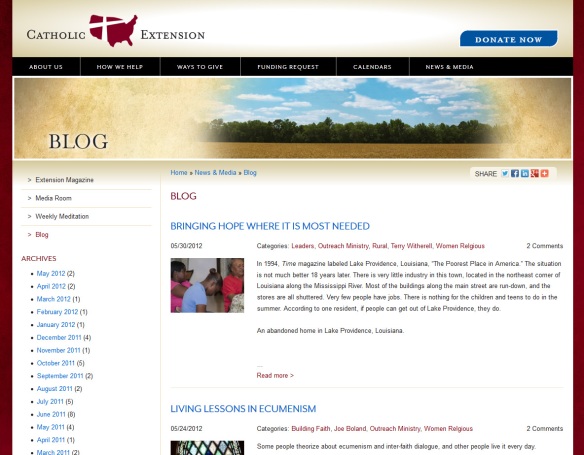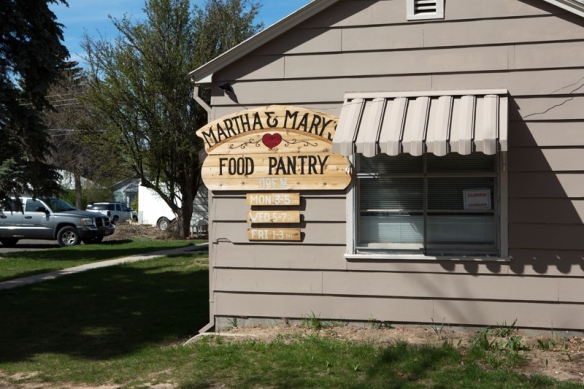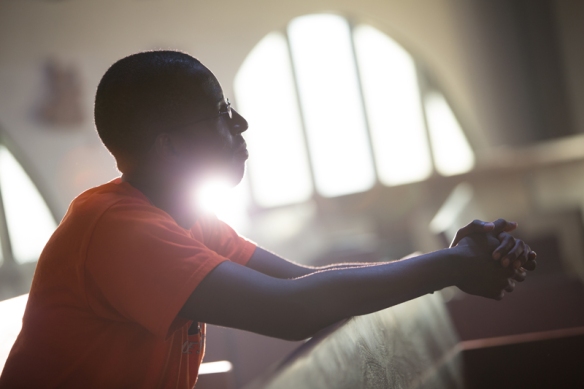The Catholic Extension Blog has moved to our brand new website. It can be found by visiting www.catholicextension.org/blog. We hope to see you there – where we will continue to share inspiring stories of faith from across the United States.
Category Archives: Igniting Change
Meeting People Halfway
I recently had the privilege of visiting communities in Idaho that are supported by Catholic Extension. The Catholic community is spread across a diocese spanning the entire state of Idaho. Catholics represent only about 11% of the population and many of the communities are rural and working class who are struggling in the wake of this uncertain economy. Needless to say, it’s a bit of a challenge to create a vibrant church experience in these circumstances. Yet, everywhere I went in Idaho I encountered passionate Catholics who are deeply committed to the faith, doing their absolute best to reach marginalized populations, and generate growth in the Church.
I visited St. Jerome parish in southern Idaho, where Catholic Extension provides support for pastoral programs. This is a bi-cultural parish that has done an excellent job of figuring out how to welcome everybody.
Just ten years ago, their Sunday Mass attracted no more than 300 people. But today, Mass is attended by 1,500 people, including families that drive as far as 70 miles to get there every week.
The parish offers religious education in two languages to hundreds of children, and classrooms are packed to capacity. “We used to have very small classes,” said Katie, the director of religious education who grew up in the parish, “This year we got to the number 300 and I thought, ‘what are we going to do with all these kids?’” Parishioners acknowledge that this type of logistical issue is in fact a blessing.
Fr. Ron, the pastor, said that “We just try to meet people halfway.”
This mentality of ‘meeting people halfway’ is at the heart of St. Jerome’s effort to feed hundreds of people and families on a weekly basis out of the parish food pantry.
This spirit of welcome also drives their work with local teenagers, many of whom are facing hard decisions about drugs and gangs. A young adult named Gio, who works with the 60+ members of the youth group, had his share of struggles as a teen growing up in Jerome, Idaho. But one parish retreat called “Come and See” changed his life so much so, that thereafter he committed himself to bringing moral strength and faith to today’s young people who face the same challenges that he once did.
Up the road two hours, I paid a visit to St. Paul’s Newman Center at Boise State University, where Catholic Extension has provided operations support for the past several years. There too, I learned about all the ways that this ministry is ‘meeting people halfway.’
The worn out, orange carpeting and the musty couches with out-of-style patterns that adorn this facility would suggest that this campus ministry has seen better days. However, the opposite is true. This ministry’s impact continues to increase. I met a group of students over lunch that seemed to have just as much confidence talking about their Catholic faith as they did discussing their beloved university football team.
At least three students shared similar stories about how Catholicism had never been a part of their lives growing up. But, they were invited to St. Paul’s Newman Center by their peers and have decided to become fully practicing Catholics after experiencing the joy of this faith community.
As many as 12 of the approximately 300 students who are part of St. Paul’s Newman Center are currently considering vocations to the priesthood and religious life.
We met a young woman who came into the Church at Easter Vigil in 2009 through St. Paul’s RCIA program. She is now seriously discerning a vocation to religious life and credits the supportive faith community of St. Paul with giving her the courage to do so.
When the Church meets people where they are at, it increases its ability to reach more. The Catholic communities in Boise have figured this out and used this wisdom to their advantage.
— Joe Boland, Senior Director of Grants Management, Catholic Extension
Putting a Price on the Invaluable
During my recent trip to Puerto Rico, I met the extraordinary Missionaries of Villaregia in the Diocese of Arecibo, Puerto Rico. The Missionaries are a congregation of 16 men and women who minister to the spiritually and materially poor. They work particularly closely with at-risk youth and families in crisis by inviting them into a community of faith and teaching them what can be possible in life when love is at the heart of it. In any given year, they serve as many as 2,000 youths and hundreds of married couples.
The Missionaries and the local bishop have sought Catholic Extension’s support to build a missionary center that will enable them to significantly expand their ministry. My visit was intended to assess how Catholic Extension can help.
During my visit, I heard compelling stories from several young adults whose lives have been changed by the Missionaries and who now are part of this movement.
I met 24-year-old Alejandro. This law student explained that during his childhood, his parents left him. He overcame those turbulent years because the Catholic faith community, pastored by the Missionaries, became his family. It was in this community that he learned he was not alone in the world and that he, too, could be a mentor for others. Alejandro and his girlfriend, Maria, also a 24-year-old graduate student from the same parish, lead a faith-sharing group at their local university, where they read scripture and support their fellow students. On weekends, Maria and Alejandro still return to their parish to teach and mentor young children and teens.
Anna is 18-years-old. She is the direct result of the work of Alejandro and Maria at the missionary center, who have been mentoring her from a young age. She is also a new university student who is considering how she, too, can give back. She is even thinking about a vocation to religious life as a sister.
Raymond is 25-years-old and grew up in a home with a father that abused drugs and alcohol. This experience made life as a young person very difficult. One retreat, led by the Missionaries, changed his life forever. He realized that life was more than his own circumstances and learned what it meant to be loved by a family. Years later, he and his father reconciled with the help of the Missionaries. Raymond continues to do anything he can to support this life-changing ministry.
Jennifer is a 24-year-old from a Catholic family. As a teenager, she didn’t think much of herself or believe that she had much to offer the world. When she met the Missionaries of Villaregia, that all changed. Jennifer began to believe that God was calling her to do something special. Since that time, she’s discovered her sense of worth and feels ready to give back. She felt so strongly about this calling that she joined the Missionaries as a novice sister. Now in her second year, the future looks bright for Jennifer as she considers how to best live a life of service in the Church.
Maria Magdalena is a 21-year-old nursing student. She met the Missionaries as a late teen. They helped her realize that the most beautiful thing a person can do in life is to live it for others. She now helps by mentoring other young people. Tears filled her eyes as she pondered the new possibilities that new facility would bring to her ministry. “We are family and this is a house for everyone. People will come here to be fed,” she sobbed.
As these stories suggest, the Missionaries have touched the lives of many youths in the community. Their programs have become so successful that they’ve quickly outgrown their current facilities.
After 14 years of saving and two years of construction, the missionaries are just $800,000 short on cash for making the missionary center a reality. But, with just $300,000, they can finish the framing and dry wall and begin to use the center, which will accommodate as many as 900 people for gatherings and 200 overnight guests.
Fr. Roberto, who leads the Missionaries, believes that with such a strong foundation of young leaders, the new facility will be bustling with activity in no time. The only thing that stands in the way of this is a cash shortfall.
Stay tuned for Catholic Extension’s response.
— Joe Boland, Senior Director of Grants Management
Our Christmas Wish List
Now that the excitement of the Christmas season is upon us, we want to let you know about Catholic Extension’s 2010 Christmas Wish List—25 “wishes” from under-resourced and isolated dioceses across America who need your support. Please check out this year’s list and stay tuned as we highlight a different “wish” through Twitter over the next 25 days.
Click here to see the full 2010 Catholic Extension Wish List.
Father Tolton
“Nothing will be impossible for God.” (Lk 1: 37)
Last week in my “America’s Children” post, I talked about some of the real-time saints emerging among the youth in California, those brave kids who are up against tremendous forces.

Fr. Tolton overcame unthinkable adversity to be ordained as the country’s first African-American Catholic priest.
I am pleased to still be on “saint watch” this week as we witness an official saint-in-the-making from a little-known place in the U.S. called, Brush Creek, MO. The candidate for sainthood’s name is Fr. Augustine Tolton and St. Peter Church in Brush Creek is the place where he was baptized 156 years ago.
Fr. Tolton was born into slavery and later overcame unthinkable adversity to be ordained as the country’s first African-American Catholic priest. He attended St. Peter until he escaped to the free state of Illinois during the Civil War. He wanted to become a priest, but was denied access to seminaries in the U.S. So he went to the Urban College in Rome, where he was ordained in 1886. He returned to the U.S. to serve and, despite rampant racism and discrimination, he became one of Chicago’s most popular pastors, attracting members of both white and black Catholic communities. He shines as an example of what happens when Christians embrace this crazy idea that “nothing will be impossible for God.”
As we wrap up Black Catholic History Month this November, we at Catholic Extension have announced a grant to the Diocese of Jefferson City, where the tiny town of Brush Creek is located. We have pledged to help the diocese repair the humble site of Fr. Tolton’s baptism, a church accessible only via gravel road, to preserve the enormously important legacy of a heroic priest of the late 19th century who is now being considered for sainthood. Pilgrims are beginning to visit this sacred place as more and more people become aware of the Fr. Tolton story through the Archdiocese of Chicago’s efforts to present his cause for canonization.
Currently, St. Martin de Porres is the Catholic Church’s only “official” saint of African descent in the Western Hemisphere. Fr. Tolton would be a welcome addition to that rank. His story in so many ways represents the rich history of African-American Catholics, who in spite of many setbacks and struggles over the years have intrinsically shaped our Catholic religious experience in the U.S. and have made us a better, more complete Church.
My own spiritual formation, in a very personal way, has been influenced by the Black Catholic perspective here in Chicago in parish not far from where Fr. Tolton once ministered a century ago. For several years, I attended a church whose goal, which many parishioners could repeat verbatim, was “to bring one more soul closer to Christ and to help somebody along the way.” For me, this sums up both the spiritual and the social dimensions of Christianity that African American Catholics intuitively understand and embody.
Fr. Tolton’s story reminds us of the truth that is also at the heart of Catholic Extension’s work: the greatest among us emerge from the least-expected places. Our grant to St. Peter will enable the Diocese of Jefferson City to preserve the rich legacy of America’s first African-American priest, so that Fr. Tolton’s story can continue to be shared among Catholics and give hope to communities that face immense social and economic challenges today.”
You can read more about Fr. Augustine Tolton’s life at : http://www.catholicextension.org/site/epage/108432_667.htm
— Joe Boland, Senior Director of Grants Management
For more on Catholic Extension’s journeys, follow Joe on Twitter.










